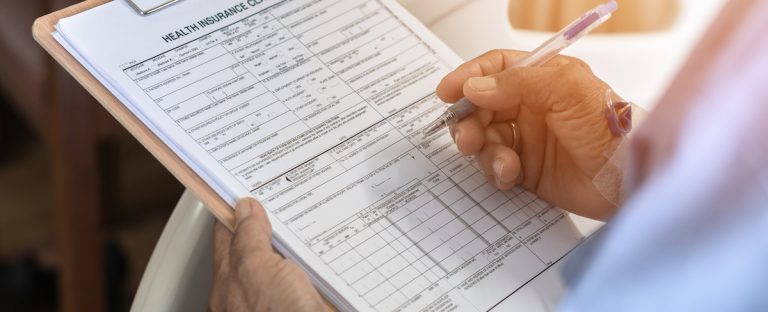The world of insurance billing is complex, and even more so for holistic practices. Understanding when to use the right acupuncture billing codes and procedures is essential to any successful medical practice – whether holistic or traditional. Accurate coding and billing practices ensure a streamlined reimbursement process so your practice can get paid and deliver the best care to your patients.
As a billing company focused on holistic healthcare providers, Holistic Billing is an expert in the world of acupuncture billing CPT codes. In any given year, roughly half of our new clients have never billed insurance before they started with Holistic Billing Services, so we are quite accustomed to their most frequently asked questions. Find the answers to many of the most common questions about Acupuncture CPT codes and billing practices below!
As a holistic practice, you want to deliver the best treatments of holistic medicine to your patients – while also ensuring you are paid! To service your patients and grow your holistic business, however, you will want to consider provider credentialing as an in-network provider to bill insurance plans. To be approved, you must meet the numerous medical credentialing requirements for your practice. Besides meeting the requirements, you also must ensure that all the complicated paperwork is filled out accurately and the right documentation is gathered.
Don’t be discouraged, however! There are ways to ensure you’re approved the first time you apply for medical credentialing. Here are some considerations to keep in mind so you have everything you need to know before starting the insurance billing credentialing process.
What is Medical Credentialing?
The process of verifying a healthcare provider’s qualifications for administering care to patients to bill insurance providers, medical credentialing is necessary to receive reimbursements for services. Medical credentialing is a common process for most insurance billing, including many commercial insurance companies, medical groups, surgery centers, or government plans like Veterans Affairs, Medicare, and Medicaid.
Generally, the medical credentialing process involves various applications, forms, and documentation, though the exact requirements vary on the insurance provider. Typically, the provider credentialing process must verify that the medical practice’s documents are current and valid. This can include medical licenses, malpractice insurance, DEA, board certifications, and any other additional information necessary to complete the credentialing process.
What are the Common Challenges in the Medical Credentialing Approval Processs?
Although the medical credentialing process is essential to receive reimbursements, there are many potential issues – and ensuing consequences – that can occur. Since provider credentialing is integral to generate revenue, it’s one of the most important processes for a holistic practice. However, data errors, accidental omissions, or any other hiccups in the process can result in incomplete credentialing and possible financial complications.
Medical practices – holistic or not – lose revenue and waste valuable time and money with common medical credentialing mistakes. So, being aware of the common challenges in the medical credentialing approval process can help avoid these costly errors!
Incomplete Applications
A common mistake that plagues medical practices, sending incomplete provider enrollment applications can set back the provider credentialing process for weeks, if not months. The general application for credentialing requires an extensive amount of paperwork and documentation – all that needs to be filled out correctly. Failure to complete the provider credentialing application accurately can result in lengthy reimbursement delays and denied claims that can negatively impact your bottom line.
While some mistakes are inevitable, ensuring qualified credentialing helps eliminate the margin for human error, saving your holistic practice time and money.
Lack of Organization
An organized practice can lead to inaccurate provider credentialing applications, lost paperwork, or extra time spent on the entire process as a whole. Having all your important paperwork and data where it should be and gathered will avoid any issues in the future, such as claim denials or inaccurate physician contact information.
Proper organization can also make the entire medical credentialing process as efficient as possible, so your holistic practice can focus on the day-to-day operations of delivering services to patients and receiving payments.
Not Updating Information
Even after healthcare providers are credentialed, all provider contact information needs to be kept up to date. Depending on the state in which you practice, licenses and credentials need to be renewed regularly. During the re-credentialing process, having up to date information on every individual practicing, including licenses and contact information, will be important for an efficient and accurate process for your holistic practice.
Besides making the process exponentially easier, keeping up to date with physician licenses will also help avoid potential bad patient outcomes if a physician is practicing without an updated license.
Medical Credentialing Checklist for Holistic Practices
To avoid possible claims denials and lengthy issues, you want to make sure your provider credentialing is as accurate the first time around as possible. Since the medical credentialing process can be lengthy and full of complicated documentation, a checklist can help ensure no important data is missing.
Here are some medical credentialing checklists for holistic practices to help provide an accurate and speedy credentialing outcome! Remember that, depending on the state in which you practice, you may have additional medical credentialing requirements that are not fully covered by the process.
Massage Therapy Credentialing

- Know your state requirements for holistic practices
- Provide your NPI (National Provider Identification)
- List all relevant professional licenses
- Provide any evidence of education or training
- Include all board certifications
- Include DEA certifications
- Malpractice Insurance, if applicable
- Current Competence to Practice certifications
Chiropractic Credentialing

- Know your state requirements for chiropractic holistic practices
- Get your NPI (National Provider Identification)
- Licensure: All practitioners must have and maintain a current, unrevoked, unsuspended, and unimpaired license to practice chiropractic in the state where their holistic practice is
- List education or training
- Practitioners must also complete and maintain all continuing education hours as required
- If your practice performs X-rays, make sure to follow radiographic guidelines and x-ray criteria
- Include all board certifications
- Include DEA certifications
- Malpractice Insurance, if applicable
- Current Competence to Practice certifications
Acupuncture Credentialing

These are essentially the basics for acupuncture credentialing in most states in the District of Columbia.
- Graduated from an academic program with U.S. Department of Education recognized accrediting agency
- Passed relevant licensing or certification examinations, or is nationally board certified by the NCCAOM®
- Holds a license in the appropriate jurisdiction
- Education or training
- Include all board certifications
- Include DEA certifications
- Malpractice Insurance, if applicable
- Current Competence to Practice
Turn to Holistic Billing Service’s Medical Credentialing Services to Get Approved for a Network the First Time Around!
Medical credentialing for holistic practices can be a lengthy and complicated process, but one that is an option to receive reimbursements from insurance companies as an in-network provider. An efficient and accurate provider credentialing service is essential for a healthy bottom line, but the process can be full of complicated paperwork that needs to be filled out precisely. By outsourcing your medical credentialing to professionals, you can trust that your credentialing is filled out correctly – the first time around!
At Holistic Billing Services, you can trust our team of experienced billing and coding experts to understand the unique needs of holistic practices and can help you take steps to accelerate your revenue cycle management and avoid claim denials. Since we deal exclusively with holistic healthcare practices like acupuncture, massage therapy, and chiropractic treatments, we are familiar with the medical credentialing approval process and how it affects your business. For any questions about holistic billing, feel free to contact our team today, and let us know how we can help your holistic practice!
The opioid crisis is one of the major health challenges in the United States today, and it’s responsible for destroying thousands of lives. Whether addiction stems from prescription medications or illegal street drugs, more than two million Americans are victims of opioid misuse.
Finding alternatives to highly addictive opioid drugs is a crucial key to combating this epidemic. Increasingly, holistic practices have been looked at as safer and more effective alternatives to opioids. Acupuncture treatments, among other drug-free therapies, offer pain management solutions with minimal burden to patients, opening up a wide variety of opportunities for people to seek pain relief without the side effects of opioid drugs.
Understanding the Opioid Crisis
 The United States is in what’s currently being described as the “Opioid Crisis.” Up to 130 people die every day in the United States from opioid overdoses. The misuse of opioids, ranging from heroin, prescription pain relievers, and synthetics such as fentanyl, has become a severe burden on social and economic welfare, as well as a public health crisis. The Centers for Disease Control and Prevention estimate that the epidemic costs the United States $78.5 billion a year, including treatment costs, law enforcement, healthcare, and lost productivity.
The United States is in what’s currently being described as the “Opioid Crisis.” Up to 130 people die every day in the United States from opioid overdoses. The misuse of opioids, ranging from heroin, prescription pain relievers, and synthetics such as fentanyl, has become a severe burden on social and economic welfare, as well as a public health crisis. The Centers for Disease Control and Prevention estimate that the epidemic costs the United States $78.5 billion a year, including treatment costs, law enforcement, healthcare, and lost productivity.
The crisis has its roots in the late 1990s when pharmaceutical companies reassured doctors that opioid pain relievers were safe and addiction-free, leaving healthcare providers to prescribe them in great numbers to patients who complained of pain. The massive influx of prescription drugs has led to many patients becoming addicted, despite never touching illegal drugs. This led to the mass availability of heroin and synthetics, such as fentanyl, on the illegal market, allowing for the current widespread abuse of opioids in the country.
By the late 2010s, the crisis had reached emergency proportions. On October 26, 2017, the United States officially declared the opioid crisis as a National Public Health Emergency and the federal government began necessary taking steps to address the epidemic. The United States Department of Health and Human Services’ Five-Point Opioid Strategy was released in April 2017 as a framework for the federal response to the epidemic. The strategy partially aims to,
“Support cutting-edge research that advances our understanding of pain and addiction, leading to the development of new treatments, and identifies public health interventions to reduce opioid-related health harms…”
This is key for developing pain treatments that are alternatives to opioid drugs. Many have recognized the importance of holistic medicine, especially acupuncture treatments as alternative methods of pain management.
Holistic Alternatives to Opioid Drugs
The options of other pain management methods over opioid drugs have increased with the crisis’s severity. Popular alternatives for pain medications range from over-the-counter drugs, such as acetaminophen (Tylenol), to non-drug therapies that are used in conjunction with non-addictive medications. These include:
Physical Therapy
Physical therapy has been widely seen as a successful alternative to opioid drugs. Physical medicine and rehabilitation include options such as deep-muscle and ultrasound massages, whirlpools, as well as traditional physical therapy exercise programs that can prevent and manage pain from injuries or disabilities.
Yoga
This meditative movement practice has surged in popularity over the years and can not only improve fitness and reduce stress, but has been found to especially reduce discomfort in people with lower back pain. It also features mind-body techniques, including breathing exercises that can help induce relaxation and lower anxiety.
Acupuncture
This increasingly popular ancient Chinese practice uses fine needles inserted in various “acupuncture points” across the body to treat pain. Since the needles are so small, they themselves do not inflict pain but can provide significant pain relief for those with regular appointments by interrupting pain signals throughout the body.
Is Acupuncture an Effective Opioid Drug Alternative?
Acupuncture is an effective pain management alternative to opioid drugs and is at the forefront of some of the more touted holistic alternatives to pain issues. When performed by licensed acupuncturists, acupuncture is a safe and powerful modality for pain management for a variety of injuries and disabilities without the destructive side effects of opioid drugs.
One meta-analysis of almost 18,000 patients across 29 randomized controlled trials found that certified, accurate acupuncture was significantly more effective than the absence of the service.
It’s becoming increasingly accepted that acupuncture could be prioritized as a replacement for opioid drugs for both chronic and acute pain. Despite their effectiveness, acupuncture treatments are minimally invasive so they cause minimal burden to patients with no lasting side effects.
What Does Acupuncture Treat?
Acupuncture treatments can be used to treat a wide range of symptoms, including stress management, pain control, and neurological and respiratory disorders. When used as an opioid drug alternative, acupuncture treatments can be manifested as either treatment for pain management or as an opioid replacement.
Acupuncture for Pain Relief
Acupuncture treatments have been increasingly known as the “go-to” for integrative therapy for its effectiveness on pain relief. According to the National Institute of Health (NIH), results from a number of studies have found that acupuncture treatments reduce pain for a number of ailments, including types of pain that are often chronic such as low-back pain, neck pain, and osteoarthritis/knee pain.
Additionally, the side effects are minimal when compared to other pain management solutions. Relatively few complications from acupuncture have been reported when it’s administered correctly. In 2017, the American College of Physicians issued recommendations for treating chronic lower back pain, including acupuncture as an effective non-drug therapy. As providers try to limit prescribing opioid drugs as pain management options, effective and as safe therapies such as acupuncture treatments are increasingly pushed to the forefront of pain control methods.
Acupuncture as an Opioid Drug Alternative
Acupuncture has the potential to become a front-line treatment for pain management, reducing the number of opioid drug prescriptions being issued. As an opioid drug alternative, acupuncture treatments can be used in place of the prescriptions for acute to chronic pain for the same effects with only minimal burden on the patient.
A Cochrane study of five randomized trials and 285 patients found benefits of acupuncture for cancer pain relief when compared to traditional pain medications, which are often opioid drugs. Additionally, some studies suggest that acupuncture activities opioid receptors in the brain. When used in conjunction with acupuncture treatments, this would likely allow for lower doses of opioid medication to be needed for patients with severe pain.
What are the Health Benefits of Acupuncture?
The health benefits of acupuncture treatments are numerous and can be used to treat a wide variety of medical conditions and symptoms. Besides its benefits as an opioid drug alternative, acupuncture can be used to treat everything from migraines and headaches to recovery from surgery.
While the NCCIH notes that acupuncture treatments have been proven to help treat lower back pain, neck pain, osteoarthritis, knee pain, and chronic migraines, the Acupuncture Evidence Project reviewed the effectiveness of acupuncture for 122 treatments over 14 clinical areas and have found some evidence of effect for 117 conditions.
Other conditions that acupuncture treatments can relieve pain for include:

- High and low blood pressure
- Chemotherapy-induced nausea and vomiting
- Facial pain
- Morning sickness
- Dental pain
- Inducing labor
Additionally, one of the more attractive benefits of acupuncture is that there are minimal side effects when compared to medication drugs, such as opioids. It’s a safe and non-addictive method for those looking for a minimally invasive pain solution.
Let HBS Handle Your Billing for Acupuncture Services so You Can Focus on Delivering Better Patient Care!
As the acupuncture service industry expands, you want to focus on growing your holistic practice and ensuring that your patients are receiving the best in acupuncture treatments. Billing for acupuncture services can be tedious, but it doesn’t have to be.
Holistic Billing Services specializes in the unique requirements of acupuncture practices to ensure that they get the insurance reimbursements they’re entitled to receive for their services. By partnering with an experienced medical billing team, you can spend less time thinking about managing the ins and outs of CPT coding and insurance claims and more time delivering higher-quality care to your current patients.
Ready to accelerate your practice’s revenue cycle management and grow your acupuncture practice? Contact our billing and coding experts today.
On January 21st, 2020, the Centers for Medicare and Medicaid Services (CMS) announced their decision to cover acupuncture for chronic low back pain. This is defined as localized pain in the lower back that persists for more than three months. The decision was momentous because it marked the first time acupuncture services could be reimbursed by Medicare.
Unfortunately, the decision also created a great deal of confusion. While Medicare now covers acupuncture services for lower back pain, there are a number of important conditions that must be met for treatment to be eligible for acupuncture billing. This makes many wonder what factors are considered for Medicare acupuncture coverage.
For example, the treatment must be administered under the “adequate supervision” of a physician, physician assistant, or nurse practitioner. This may sound simple enough, but the language used by the CMS ruling to define who may administer that treatment is deceptively complex.
Does Medicare Pay for Acupuncture?
The simple answer? Medicare doesn’t cover acupuncture for any condition other than chronic low back pain.
There are also additional acupuncture insurance billing requirements to follow, although the ruling has created the impression that any licensed acupuncturist can bill services to Medicare as long as they administer treatment in the presence of a physician, physician, assistant, or nurse practitioner. However, this is not an accurate interpretation of the CMS decision.
The ruling clearly states that a provider must be an MD/DO, physician assistant, nurse practitioner, clinical nurse specialist, or auxiliary personnel. They must also “possess a master’s or doctoral-level degree in acupuncture or Oriental Medicine from a school accredited by the Accreditation Commission on Acupuncture and Oriental Medicine (ACAOM)” and hold a “current, full, active, and unrestricted license to practice acupuncture” in the state.
Some holistic practices have seized upon the category of “auxiliary personnel” and taken it to mean something akin to an independent contractor. While an independent Licensed Acupuncturist may qualify as auxiliary personnel, the CMS ruling is quite clear on how this category can administer treatment:
“Auxiliary personnel furnishing acupuncture must be under the appropriate level of supervision of a physician, physician assistant, or nurse practitioner/clinical nurse specialist required by regulations…”
The key phrase here is “appropriate level of supervision,” which is typically interpreted under Medicare guidelines to mean that the person providing the service is “incident to” a physician’s professional services or hospital services. Put simply, means that the acupuncturist is administering treatment on behalf of the physician as part of the physician’s practice. All auxiliary personnel must, therefore, be supervised by the authorized Medicare provider.
Following this logic, then, auxiliary personnel cannot directly bill Medicare for any services rendered because they are not the registered Medicare provider. The supervising physician may bill Medicare for acupuncture treatments for lower back pain (with some restrictions), but the acupuncturist cannot do so themselves.
Furthermore, since licensed acupuncturists are not currently included on the list of Medicare provider groups, there is currently no way for them to directly bill Medicare for reimbursement. Hypothetically, if they were added to the list of qualified provider groups, they would be able to bill for eligible services (currently chronic lower back pain).
Unfortunately, an act of Congress would be necessary to expand the list of provider groups. Despite several attempts to add acupuncturists to the list of Medicare providers over the past 40 years (most recently with the Acupuncture for Heroes and Seniors Act, introduced in 2015 and reintroduced in 2017 and 2019), none of them have received a committee hearing in Congress.
Current State of Medicare Acupuncture Coverage
According to Medicare, back pain can be covered if it meets the following conditions:
- It has lasted 12 weeks or longer.
- There is no known cause (not related to cancer that has spread, inflammatory, or infectious disease).
- Pain not associated with surgery or pregnancy.
As of current Medicare acupuncture coverage regulations, no other sources of back pain will be covered. However, it’s not that simple. Since Licensed Acupuncturists are still not included on the list of Medicare provider groups, most acupuncture practices will be unable to deliver Medicare-approved acupuncture until an act of Congress changes the current verbiage to include them.
Additionally, Medicare guidelines state that a Medicare-approved acupuncture treatment must be no more than 45 minutes. Insurance companies may be inclined to decline payments if they receive an insurance claim from a provider for a 60-minute treatment.
While this CMS decision has made progress, it still does not serve the acupuncturing community as effectively as it may appear since the greater majority of Licensed Acupuncturists cannot deliver services covered by Medicare still unless they are working for a physician.
Acupuncture Medicare Fee Schedule
For Medicare-covered acupuncture, guidelines stipulate that up to 12 visits in the first 90 days may be covered for Medicare beneficiaries.
Up to eight additional sessions may be covered for patients who demonstrate improvement, but no more than 20 acupuncture treatments may be administered annually. Treatment must also be discontinued if the patient is not improving or is regressing.
The current rules cover the following acupuncture treatment codes (at the current Medicare national average fee schedule)
- 97810 ($37.89): Acupuncture, one or more needles, without electrical stimulation, initial 15 minutes of personal one-on-one contact with the patient.
- 97811 ($28.87): Each additional 15 minutes of personal one-on-one contact with the patient, with re-insertion of needles.
- 97813 ($42.22): Acupuncture, one or more needles, with electrical stimulation, initial 15 minutes of personal one-on-one contact with the patient.
- 97814 ($34.65): Each additional 15 minutes of personal one-on-one contact with the patient, with re-insertion of needles.
- 20560 ($26.71): Services with needle insertion(s) without injection(s) of 1 or 2 muscle(s).
- 20561 ($39.70): Services with needle insertion(s) without injection(s) of 3 or more muscle(s).
The Future of Medicare Billing for Acupuncture Services
While most acupuncture practitioners are currently ineligible to provide Medicare-covered services for patients, there are movements in place to change the verbiage surrounding acupuncture in the Social Security act to include more of the acupuncturing community.
The American Society of Acupuncturists is currently at work drafting a bill for Congress and gathering support to make a change to the existing guidelines. In early 2021, their goal is to secure bipartisan support for the bill and organize acupuncturist advocacy campaigns to increase awareness of their bill. For more information, check out the plan here.
At Holistic Billing Services, we deal exclusively with holistic healthcare practices like acupuncture, massage therapy, and chiropractic treatment. Our team of experienced billing and coding experts understand the unique needs of holistic practices – such as acupuncturist practices – and can help you take steps to accelerate your revenue cycle management. For any questions about holistic billing, feel free to contact our team today and let us know how we can help your acupuncture practice.
As acupuncture insurance billing experts, we’ve been getting numerous questions from acupuncture providers reporting claim denials for 60-minute visits that used to pay without issues. Read on for our answer to this recently asked question!
Why Are My Acupuncture Visits Exceeding 45 Minutes Getting Denied?
|
Typically, commercial insurance companies peg their reimbursement rates and procedure protocols to the Centers for Medicare and Medicaid Services’ (CMS) published guidelines. It is common to find language in insurance contracts expressing reimbursement rates as a multiple or percentage of a CMS fee schedule. Historically, the coding guidelines and pricing did not affect the average acupuncture practitioner as CMS did not recognize the most frequently used acupuncture codes. However, on Tuesday, January 21st, 2020, CMS announced their decision to cover acupuncture for chronic low back pain, defined as localized pain in the lower back that persists for more than three months. CPT Codes and Associated Fee SchedulesHere are the CPT code, fee schedule, and max units for some of the most common acupuncture billing codes:
|
Additional CMS Updates for Acupuncture PracticesAlong with the announcement that acupuncture will now be covered for chronic low pain, CMS provided pricing and usage guidance for acupuncturists. As commercial payers and Veterans Affairs (Triwest and Optum) update their systems, many will follow the new pricing and Medically Unlikely Edits (MUE) values for acupuncture codes. Reduce Claims Denials in Your Acupuncture Practice with Holistic Billing!Due to these changes, insurance companies may start denying claims with acupuncture visits exceeding 45 minutes. If your insurance payer is adopting these policies, please ensure you’re adhering to these new billing requirements to avoid these denials. If you need assistance meeting billing requirements, turn to Holistic Billing Services! With our help, you can start seeing patients covered by insurance quickly and painlessly, no matter what type of acupuncture services you offer. After you’ve successfully enrolled in our easy-to-access portal for health insurance billing, you’re ready to get started generating revenue for your acupuncture services! Just send us the details of the treatment you’ve provided and our acupuncture billing experts take care of the rest. Have additional questions about medical credentialing for holistic practices, EHR, or medical billing for your acupuncture practice? Reach out to one of our experts today! |
Are your insurance reimbursements taking longer to process than they should? Or do your claims always seem to be turned down for not providing information the insurer never asked for? If your practice keeps encountering these problems, you could have a strong legal case for filing a complaint against the insurer. Holistic Billing Services has walked plenty of acupuncture, massage therapy, and chiropractic practices through the complaint process over the years. Here’s a look at what we’ve learned along the way.
Your Holistic Practice and Health Insurance Complaints
Here is a tip most people billing insurance for holistic healthcare aren‘t aware of: most states have “prompt payment” legislation in place where insurers are required to resolve each provider dispute consistent with applicable law and issue a written determination usually within 45 working days after the date of receipt of the provider dispute. If you feel you have exhausted all of your options with the insurer in resolving a clean claim, take advantage of these laws by contacting your state‘s insurance commissioner to file a complaint.
How Do Prompt Payment Laws Work?
Prompt pay laws require insurance companies to either pay or deny claims from healthcare providers within a reasonable period of time. That amount of time varies by state, but is typically between 15 to 60 days. The timeframe is often shorter for electronic claims compared to old-fashioned paper claims. States attempt to compel prompt payment by imposing penalties on insurers who fail to comply with the payment deadline.
There are some exceptions to these requirements. If the insurer needs more information or proof of additional insurance, they can receive an extension so long as they request the necessary information within the original time period. Once they receive the additional information, they are still obligated to process the insurance reimbursement in a timely manner.
Failure to comply with prompt payment requirements can carry substantial penalties, often in the form of interest payments to the provider. Insurance companies that are habitually late in their payments could also be hit by the state with hefty fines, like the $1 million fine Pennsylvania levied on UnitedHealthcare in 2019 or the $10 million fine Texas imposed on Blue Cross Blue Shield of Texas in 2020 (for prompt pay and other violations).
What Qualifies as a Clean Claim?
It’s important to remember that prompt payment laws apply specifically to clean claims. These are claims that use a standard claim form (typically claim form CMS-1500, formerly known as HCFA 1500, or claim form UB-04) or the specific electronic system used by the insurer. In both cases, the practice must be sure to complete the required fields with all the information necessary to process the claim.
“Clean” refers to both the completeness and accuracy of a submission. Insurance providers are typically quite clear about the specific information they need when providers submit a claim for processing. Documentation sometimes needs to be submitted along with certain CPT codes, so it’s important for practices to always accurately document what treatments are being administered and how time is being accounted for (especially when it comes to the new E&M billing guidelines).
When and Why to File Insurance Complaints
If an insurer is taking longer than expected to process a claim, your first step should be to check the prompt payment guidelines in your state. The Department of Insurance can provide more detailed information about the claims process and the requirements facing insurers (look up your state’s information here).
Once you’ve determined that the insurer has missed the prompt pay deadline in your state and has not requested additional information from you, the next step is to begin filing a claim. While the process can be a bit time consuming and involve some additional legwork, it’s important to hold insurance companies accountable when they fail to comply with state law. Simply giving them more time to process your claim may result in you not getting paid at all, and it may prevent you from collecting interest payments you are legally entitled to receive.
When the time comes to follow up on a claim, it’s helpful to have an experienced billing provider with a history of representing holistic practices at your side. Before you begin the complaint process, consider reaching out to a partner who already knows what steps to take in order to resolve the dispute quickly and favorably.
How to File a Complaint Against a Health Insurance Company
Step 1: Contact the Insurer
When contacting the insurer to file a complaint, be sure to remind them of your state’s prompt pay requirements and present them with detailed information about your claim (such as the date it was submitted and proof that it was delivered to them). The insurer may argue that they never received the claim, in which case you should be able to provide a copy of the original claim. Document all correspondence with the insurance company, preserving all written or electronic communication and making note of who you spoke to, when, and what you discussed.
Step 2: Escalate to Your State’s Department of Insurance
If the insurer is unable or unwilling to resolve the situation, your next recourse is to escalate the complaint to state authorities. Your state’s Department of Insurance has special complaint forms available (usually on their website) for filing complaints regarding prompt pay violations. State officials will need detailed information about your claim and your correspondence with the insurance company. This is where your extensive documentation will prove invaluable.
Protect Your Practice with Holistic Billing Services
As a medical billing provider specializing in acupuncture, massage therapy, and chiropractic services, Holistic Billing Services has extensive experience dealing with prompt payment complaints against insurers. We can walk you through every step of the process to ensure that you have all your documentation in order and are in the best position to secure the insurance reimbursement revenue (and potential interest payments) you’re entitled to under the laws of your state. With Holistic Billing’s help, you can keep your focus on your practice while we handle the ins and outs of the complaint process.
To find out what else an experienced billing provider can do for your practice and your revenue cycle management, contact our team today for a consultation.
Operating a successful acupuncture practice can be a rewarding and worthwhile endeavor that makes a real difference in the lives of patients. Unfortunately, it can also be quite a challenge thanks to confusion over how to bill for services effectively. The ins and outs of medical coding are complex and even a minor error can cause a claim to be denied by insurance providers.
What Are Billable Units?
Like other therapy-based practices, acupuncture practices bill their services according to Current Procedural Terminology (CPT) codes. Each code is considered a billable unit used to track what treatments have been administered. Some of these codes are service-based, representing a specific billing amount for a specific treatment. It doesn’t matter how much time it takes for this treatment to be administered. For billing and coding purposes, a service-based code has the same unit value (in this case, one unit), regardless of whether it takes twenty minutes or two hours to administer treatment (although each code has an average expected treatment time). Only one unit of service-based codes can be billed at any one time.
Many acupuncture codes, however, are time-based or multiple-unit codes. This means that each code is billed according to 15-minute increments. Most insurance providers follow Medicare guidelines when it comes to measuring this time. Often referred to as the “Medicare 8 Minute Rule” or the “Rule of Eights,” Medicare’s standards for outpatient therapy services require practices to deliver direct, one-on-one therapy for at least eight minutes to receive reimbursement for a time-based CPT code.
Medicare calculates billable units by dividing the total minutes of direct therapy time by 15 and then rounding the remaining value up or down according to the Medicare 8 Minute Rule. For instance, if a time-based acupuncture treatment (such as ICD-10 code 97811 for subsequent acupuncture) takes 20 minutes to administer, the practice would only be able to bill for one unit (the remainder of 5 minutes would not qualify for an additional unit). If the treatment took 23 minutes, however, it would be able to bill for two units (the remainder of 8 minutes does qualify for an additional unit).
Why Is Accurately Calculating Billable Units Essential for Your Acupuncture Practice?
Since most acupuncture treatments involve direct, one-on-one therapy, they are classified as time-based codes. That means that an acupuncture practice needs to be very diligent and precise when it comes to calculating billable units. Failing to accurately document the amount of treatment time could result in rejected claims or far lower reimbursements than the practice should receive.
A typical 60-minute acupuncture treatment, for example, consists of four distinct billing units:
- 1 Unit of Initial Acupuncture (Code 97810): This treatment consists of the initial insertion of needles, which obviously requires one-on-one contact with the patient. The initial insertion is expected to take 15 minutes.
- 3 Units of Subsequent Acupuncture (Code 97811): This code covers any follow-up one-on-one, direct treatment by the acupuncturist after the initial treatment.
Where some practices get into trouble is when they fail to bill for multiple units. In the above scenario, the practice could mistakenly submit this claim:
- Initial Acupuncture 97810
- Acupuncture: 15 min 97811
when it should be submitting this claim:
- Initial Acupuncture 97810
- 1 unit
- Acupuncture: 15 min 97811
- 3 units
Failing to calculate billable units correctly can cause acupuncture practices to miss out on collecting revenue for treatments they’ve provided. In this case, the practice would have missed out on two units of code 97811. Spread over multiple patients, it’s easy to see how these oversights could add up quickly and have a devastating impact on a practice’s revenue cycle management.
3 Best Practices for Calculating Billable Units
1. Know Your Acupuncture Codes
One of the best ways to ensure billable units are being calculated accurately is to become very familiar with the most frequently used acupuncture treatment codes. This goes beyond the most basic codes for initial care to include services like evaluation management codes and more specific modalities. Every practice needs to know which codes can be billed multiple times to ensure that it’s being accurately reimbursed for its services.
2. Track Your Time and Treatments Accurately
Simply knowing which codes to use and which ones can be billed as multiple units is important, but that knowledge won’t be of much use if a practice doesn’t keep detailed and accurate records about patient treatments. Acupuncture practitioners need to document how much time they spend delivering direct, one-on-one care throughout the day.
This is especially important when it comes to auditing purposes, as they need to make sure they’re not overestimating how much time they’ve spent administering treatments. Technically, a provider cannot deliver more than four billable units of care in an hour because each unit is broken into 15-minute increments. If a practice seems to be billing more units than its staff can actually deliver, it could be inviting unwelcome scrutiny by external auditors.
3. Partner With an Acupuncture Billing Service
Delivering quality can be difficult when a practice also has to dedicate time to managing billing insurance providers for reimbursements. Since there are only so many hours in the day, most acupuncture physicians want to treat as many patients as possible in that time, which leaves little opportunity to handle the sometimes tedious paperwork of billing and coding. That’s why partnering with an experienced holistic billing service can be extremely beneficial.
Outsourcing the hassle of billing and coding to a trusted partner allows an acupuncture practice to see more patients and deliver better care without having to worry about whether or not they’re calculating the correct number of billable units.
Holistic Billing Services Can Help
Holistic Billing offers a variety of billing services for acupuncture, massage, and other integrated healthcare practices. In addition to our extensive experience with insurance billing, we understand the unique needs of these practices and what sets them apart from other medical practices.
Our certified team of coders, MBAs, CPAs, and IT professionals can help you get your claims reimbursed quickly and set up a reporting dashboard that makes it easier than ever for you to get a comprehensive view of your business. Contact us today to tell us all about your practice’s unique needs.
Operating a healthcare practice of any kind, whether it’s a western-style medical office or a holistic health service, is a challenging and complicated undertaking. As if providing quality care to patients wasn’t difficult enough, there are many other factors practices must take into account if they want to be successful. Learning the ins and outs of health insurance coverage, for instance, is an ongoing process that changes every year as provider policies are updated. Implementing processes and systems for collecting revenue is also essential, especially if many of the practice’s health services aren’t covered by insurance.
Most of these issues fall under the broad responsibilities of healthcare management and healthcare administration. While these terms are quite common, there is a lot of confusion around them because they are often used interchangeably despite the fact that they do have specific meanings.
The Difference Between Healthcare Administration and Healthcare Management
What is Healthcare Management?
As the term “management” might suggest, this area refers primarily to how the business aspects of a healthcare or holistic practice are handled. The primary focus of healthcare management is to develop a business plan that meets the practice’s specific goals and then execute on that plan using a variety of management, negotiation, and leadership techniques. Most healthcare management professionals hold an MBA or have a background in accounting or facilities management. They are typically responsible for budget management, organizational policies, standards of patient care, marketing, compliance, and various aspects of healthcare law.
What is Healthcare Administration?
While healthcare management emphasizes the business side of a practice, healthcare administration is more focused on overseeing and coordinating the staff within a practice or department. The typical healthcare administrator supports the policies and processes that help medical personnel deliver effective care that impacts patients. While they may at times be responsible for meeting regulatory requirements that are associated with healthcare management, healthcare administrators primarily support, direct, and encourage employees to ensure that they are able to provide the best care. Crucially, they are often considered to be healthcare professionals, and it is common for these roles to be filled by physicians, nurses, or other public health specialists.
Healthcare Administration vs Healthcare Management: Who Handles Medical Billing?
There are a lot of similarities between these roles, and the distinctions are made even more confusing by healthcare organizations that use the terms interchangeably. In general, however, the primary difference is that healthcare managers are responsible for the operation of a facility as a whole while healthcare administrators oversee the operations of specific departments and medical staff.
So which of these roles is responsible for medical billing?
Perhaps predictably, it depends on the specific practice.
Larger healthcare practices and medical facilities generally have dedicated medical billers who are responsible for coding medical services and then filing and submitting claims. Some organizations classify this role as a management position while others consider it administrative. In most cases, medical billers are not required to have any medical training, which would suggest that they’re more on the management side. However, since medical billers must work closely with both medical staff and patients, their role fits more naturally within the framework of healthcare administration.
For smaller healthcare practices, the distinction is far less important because the lines between healthcare management and healthcare administration are not clearly drawn. These practices don’t have the revenue or patient volume to justify the existence of additional office personnel. In many cases, both managerial and administrative are handled by only a few (or even just one) people, in addition to many other tasks they’re responsible for. This is especially true of holistic practices, where the clinician may be responsible for every aspect of their practice without any assistance from employees.
The Value of Outsourcing Holistic Billing
For many acupuncture, massage therapy, and chiropractic practices, it can be difficult to provide quality care to patients while also keeping up with all the demands of healthcare management and administration. Medical billing, in particular, can be incredibly time-intensive, not only requiring holistic practitioners to organize, file, and monitor all billing claims, but also to keep up-to-date on the latest changes to coding and to which holistic healthcare services insurance companies will agree to cover.
Partnering with an experienced medical billing provider that specializes in holistic practices can streamline an office’s operations and allow clinicians to dedicate more of their attention to their patients. While there are many medical billing services available, it’s important to find a provider that understands the unique characteristics of holistic practices and can provide the specialized support that helps these practices to be more successful.
At Holistic Billing Services, we recognize that acupuncture, massage therapy, and chiropractic practices call for a much different approach to medical billing than traditional healthcare practices. That’s why we’ve focused specifically on this growing area of medical care and have partnered with over 1,200 practices to help them improve their revenue cycle management and boost their net collections. Our convenient and secure solutions can take the hassle of insurance verifications, claims processing, and denied claims follow-ups off your hands so you can focus on what matters most: delivering quality care to your patients.
To learn more about how our team of experts can help improve your holistic billing, contact us today for a consultation.
Today’s generation of consumers is much different than it was 20 years ago (and even 5 years ago). No matter what we’re buying or who we’re engaging with, we want communication to be as quick and seamless as possible—and preferably from our mobile devices.
As a billing company focused on holistic healthcare providers, we’ve introduced our share of acupuncturists to the world of acupuncture insurance billing codes.










